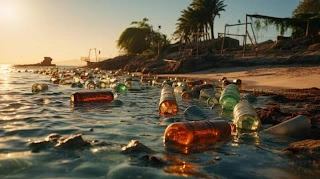Plastic! An essential part of our daily life. But how harmful is this ‘inevitable’ material to our environment, have we thought?
Plastic takes more than 1000 years to decompose in the soil. That is, the plastic waste that we throw away will not decompose in our lifetime, but will pose a great danger to future generations.
Every discarded plastic bottle, straw, plate, packaging—all ends up somewhere in the world intact. From the top of Mount Everest to the bottom of the Mariana Trench, the adverse effects of plastic pollution span every part of the world.
We all need to be aware to get rid of this dire situation. Use of plastic should be reduced, alternatives should be found. Plastic waste should be disposed of properly, recycled.
Actions must be taken today to stop plastic pollution to save both our planet and our future.
What Is Plastic And Where Does It Come From?
Materials that were “flexible and easily shaped” were called plastics. But recently it has become the name of a class of materials known as polymers. The word ‘polymer’ means “of many parts”, and polymers are made up of long chains of molecules.
Nature is not short of polymers. Cellulose, the substance that makes up plant cell walls, is a very common natural polymer.
Over the past hundred and fifty years, humans have learned to make synthetic polymers. Sometimes using natural materials such as cellulose, these polymers are often made using large amounts of carbon atoms derived from petroleum and other fossil fuels.
Synthetic polymers are composed of long chains of atoms, and are often equipped with repeating units much longer than molecules found in nature. The length of these chains and the way they are arranged make the polymer strong, light and flexible. In other words, this is what makes them so ‘plastic’.
These properties make synthetic polymers exceptionally useful. Since we have learned to create and control them, polymers have become an essential part of our lives. Especially in the last 50 years, plastics have changed our world.
Single-Use Plastic
Single-use plastic is a type of plastic that is designed to be used only once. They are discarded after use.
User convenience is given priority while developing these plastics. As a result, they become a “use and throw away” type of product.
More than 300 million tons of plastic are produced worldwide each year, and half of it is single-use.
Single-use plastics include water and soda bottles, plastic grocery bags, product packaging, straws, coffee cups, and single-use plastic bags.
Plastics And The Human Body
Plastics contain chemicals that pose a threat to human health, especially the endocrine system.
Plastic does not decompose in nature. Instead, it breaks down into tiny particles, called microplastics. These microplastics have spread to almost all parts of the world, creating serious problems for wildlife and marine life. When too much microplastic accumulates in an animal’s body, it can cause perforations in internal organs or blockages in the intestines.
Also, chemicals in plastic can cause hormonal imbalances, reproductive problems and even cancer in humans.
Single-use plastics are produced from fossil fuels. This means that the extraction and manufacture of plastic raw materials emits large amounts of greenhouse gases, which are largely responsible for environmental pollution and climate change.
Harmful Environmental Impact Of Plastic
Plastic has brought convenience to our lives, but its environmental impact is dire. Plastic pollutes soil, water and air. Plastic waste is harmful to animals. Many animals die by ingesting plastic waste. Here are some of the major environmental impacts of plastic:
- Fossil fuels and greenhouse gases It is estimated that 15 lakh to 125 lakh metric tons of greenhouse gases are released as a result of fossil fuel extraction and transportation to plastic factories. Deforestation for oil extraction and pipeline construction is adding more than 1.6 billion metric tons of carbon dioxide to the atmosphere. Plastic recycling results in an additional 18.4 to 21.3 million metric tons of greenhouse gas emissions each year. .
- Landfills and methane emissions Landfills, where single-use plastics are disposed of, account for more than 15% of methane emissions. As more plastic is dumped into landfills, it causes landfills to grow in size and these emissions increase. .
- Plastic floating in the Pacific Ocean There is a huge mass of floating plastic in the Pacific Ocean, twice the size of Texas and growing. .
- Impact on vulnerable populations Plastic pollution hits the most vulnerable populations first. Developed countries like the US send plastic to developing countries for processing. Eventually, the amount of plastic becomes so high that these communities have no way to dispose of it and are covered in plastic garbage.
Simple Ways To Reduce Plastic Use
The best way to reduce the impact of single-use plastics on climate change is to stop using them. In a world filled with an excess of plastic packaging, this can seem like a daunting task. However, even small changes can have a significant impact.
What we can do to reduce single-use plastic waste:
• Use reusable water bottles.
• Carry a reusable bag when going to the store.
• Avoid buying over-packaged items at the grocery store, such as pre-cut fruits and vegetables.
• Repurpose old bottles or containers.
• Eat home-cooked meals instead of take-out, as take-out often comes with extra plastic packaging.
• Carry cutlery set while travelling.
• Use solid soaps and shampoos instead of liquids in plastic bottles.
• Participate in local clean-up programs or pick up litter while walking, running or hiking.
• Support laws that reduce plastic use.
• Buy products from companies committed to reducing plastic use.
• Support organizations working to combat plastic pollution.
The Most Eco-Friendly Way To Dispose Of Plastic Waste
The most eco-friendly way to dispose of plastic waste is to reduce, reuse and recycle.
Reducing plastic use by using reusable products and avoiding single-use plastics is the most effective way to reduce plastic waste. Reusing plastic items like containers and bags can also help reduce the amount of plastic entering the waste stream.
Plastic recycling is another important step, as it allows materials to be reprocessed into new products, thereby reducing the need to produce unused plastic.
It is important to follow local recycling guidelines and facilities to ensure proper recycling practices. In addition, some organizations have energy recovery programs from non-recyclable plastics, which can be another environmentally friendly alternative to plastic disposal.





